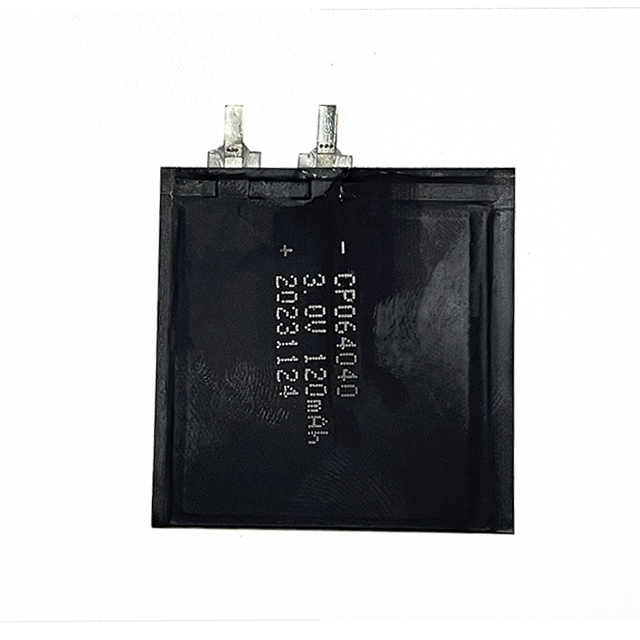Lithium-Manganese Dioxide Non-Rechargeable Ultra-Thin Soft Pack Battery: CP253025 with 3.0V and 220mAh Capacity
Lithium-Manganese Dioxide Non-Rechargeable Ultra-Thin Soft Pack Battery: CP253025 with 3.0V and 220mAh Capacity

I. Introduction
In the ever-evolving landscape of battery technology, lithium-based batteries have emerged as a dominant force due to their high energy density, low self-discharge rate, and relatively lightweight design. Among these, lithium-manganese dioxide (Li-MnO2) batteries occupy a unique niche, offering reliable performance in a variety of applications where a non-rechargeable yet long-lasting power source is desired. This article delves into the specifics of the CP253025 model, a 3.0V, 220mAh lithium-manganese dioxide ultra-thin soft pack battery, examining its construction, characteristics, applications, and potential considerations for use.
II. Overview of Lithium-Manganese Dioxide Batteries
Lithium-manganese dioxide batteries belong to the family of primary batteries, meaning they are designed for one-time use and are not rechargeable. The chemistry behind these batteries involves the reaction between lithium metal and manganese dioxide, resulting in a voltage output of approximately 3.0V. This voltage is relatively stable over the battery's discharge cycle, making it suitable for applications that require consistent power output.
III. Construction and Design of the CP253025 Battery
The CP253025 battery is a prime example of the lithium-manganese dioxide battery technology, boasting a compact ultra-thin soft pack design. Its dimensions, measuring 25mm in length, 30mm in width, and 2.5mm in thickness, make it suitable for integration into space-constrained devices. The soft pack design allows for flexibility and ease of installation, while maintaining structural integrity and safety.
The battery's internal construction comprises anode, cathode, separator, and electrolyte. The anode is composed of lithium metal, while the cathode utilizes manganese dioxide as the active material. The separator acts as a barrier between the anode and cathode, preventing direct contact while allowing the passage of lithium ions during discharge. The electrolyte, typically a non-aqueous liquid or gel, facilitates the ionic transfer between the electrodes.
IV. Performance Characteristics
The CP253025 battery offers a capacity of 220mAh, allowing it to provide a consistent 3.0V output for extended periods. Its energy density, a measure of the amount of energy stored per unit volume or weight, is relatively high, making it an efficient power source for various applications. The battery's discharge curve is relatively flat, ensuring stable performance over its entire lifespan.
The battery's shelf life, or the period during which it can be stored without significant loss of capacity, is also noteworthy. Lithium-manganese dioxide batteries are known for their long shelf lives, often exceeding several years under proper storage conditions. This characteristic makes them suitable for use in devices that may not require immediate power but need to be ready for use at any time.
V. Applications of the CP253025 Battery
The CP253025 battery's compact size, high energy density, and stable voltage output make it ideal for a wide range of applications. It is commonly found in medical devices such as glucose meters and heart rate monitors, where reliable and long-lasting power is crucial. The battery's ultra-thin design also allows for integration into slim devices like smartwatches and fitness trackers, enabling these gadgets to offer advanced features without compromising on portability.
In addition, the CP253025 battery is suitable for use in remote sensors and other IoT (Internet of Things) devices that require periodic data transmission over extended periods. Its long shelf life ensures that the devices can be stored for long durations without fear of battery degradation, while its consistent voltage output ensures reliable data transmission.
VI. Considerations for Use
While the CP253025 battery offers numerous advantages, there are a few considerations to be taken into account during its use. Firstly, as a primary battery, it is not designed for recharging. Attempting to recharge a lithium-manganese dioxide battery can lead to safety hazards such as leakage, overheating, or even explosion. Therefore, it is crucial to dispose of the battery properly once it has reached the end of its useful life.
Secondly, the battery's performance can be affected by temperature. Extreme temperatures, both high and low, can accelerate the degradation of the battery's internal components, reducing its capacity and lifespan. It is recommended to store and use the battery within the specified temperature range to ensure optimal performance.





